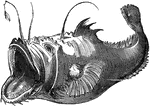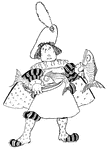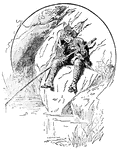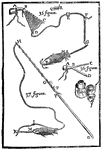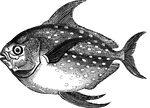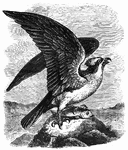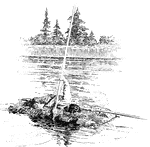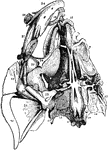Paper Koi Birthday Pole
"The fish banners are hollow so that the wind ma fill them, causing fish to rise and fall as the breeze…
Paper koi
"The Japanese carp stands for good cheer, indomitable will, perseverance, and fortitude, and it is used…
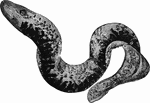
European lamprey
"The color is yellowish marked with brown. Like the sharks and rays is it without an air bladder; to…

Sea Lamprey
A lamprey is an animal which, though often regarded as a fish, differs from a fish in the absence of…
Lancelet
Lancelet fish (Branchiostoma) is sometimes called amphioxus, the type of the class Leptocardii, is a…
Lanternfish
Scopelus (Myctophum) boops is a species of deep sea lanternfish in the Myctophidae family.
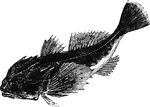
Father Lasher
"Is six to twelve inches long; feeds on small crustacea and young blennies; when troubled it sets out…
Ling
"A valuable fish, taken in large quantites on the British coasts, and salted and dried, chiefly for…
Loach
"It spawns in March or April, delights in small, shallow, clear streams, and has the habit of lurking…
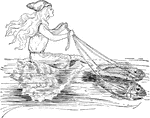
Loreley in her Chariot
Loreley, a water fairy, rides her chariot drawn by two goldfish. She was a siren, singing and distracting…

Lumpfish
"It is of thick, massive form, and often weighs as much as six or seven pounds; it is of a purplish-black…

Lungfish
In the lungfish, the development of the air bladder as a lung is much more complete than others in the…
South American Lungfish
"Lepidosiren showing (Pc.f.) pectoral fin and the tufted pelvic fin (Pv.f.) of the mature male." -Thomson,…

Lymphosporidium
An illustration of the adult amoeboid Lymphosporidium truttae, which was the cause of the brook-trout…
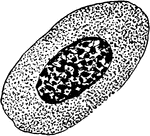
Lymphosporidium in Blood Cell
An illustration of Lymphosporidium truttae in the blood cell of a brook trout, which was the cause of…
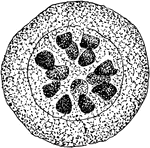
Lymphosporidium in Blood Cell
An illustration of Lymphosporidium truttae in the blood cell of a brook trout with numerous sporoblasts,…

Mackerel
The perch is typical of a large group of fishes, all of which have spiny rays. The perch is widely distributed…

Mackerel
Mackerel is a common name applied to a number of different species of fish, mostly, but not exclusively,…

Mackerel
Mackerel is a common name applied to a number of different species of fish, mostly, but not exclusively,…
Mackerel
Mackerel is a common name applied to a number of different species of fish, mostly, but not exclusively,…

Mackerel Shark
Lamniformes is an order of sharks, also known as mackerel sharks (which may also be used to refer to…

Atlantic Horse Mackerel
The Atlantic Horse Mackerel or Scad (Trachurus trachurus) is a species of mackerel in the Carangidae…

Common Mackerel
"Eaten both fresh and salted, and is caught in immense numbers in Europe and America. It is fourteen…
Atlantic Spanish Mackerel
The Atlantic Spanish Mackerel (Scomberomorus maculatus) is a migratory species of mackerel common to…
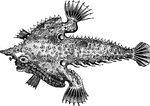
Bat Malthea
"Is ten to eighteen inches long, pale grayish-brown, snout elongated into a point, skin like shagreen,…
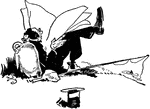
Man Reading Newspaper Next to Fishing Pole
A cartoon of a man reading a newspaper, with a fishing pole laying next to him.
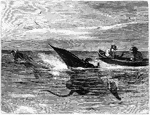
Manta Ray
The manta ray (Manta birostris), is the largest of the rays, with the largest known specimen having…
Metamorphosis of a Flounder
Flounder have both eyes situated on one side of the head, they are not born this way. Their life involves…
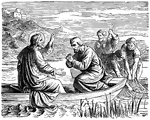
The Miraculous Draught of Fish - Jesus Fishes with His Disciples
"And when he had left speaking, he said unto Simon, Put out into the deep, and let down your nets for…
Mudfish
The mud fish is in the order Dipnoi. They resemble salamanders in the class Amphibia. (p) pectoral limbs;…
Mudfish
"Ament-A kind of inflorescence consisting of unisexual apetalous flowers growing in the axils of scales…

Mudskipper
Periophthalmus koelreuteri. PERIOPHTHALMUS, a remarkable genus of acanthopterous fishes, allied to the…
Longjaw Mudsucker
The Longjaw Mudsucker (Gillichthys mirabilis) is a fish in the Gobiidae family of gobies.
Gray Mullet
"It is a small fish, common in Europe, and greatly esteemed for its delicacy. It is very active, and…

Striped Red Mullet
"Weighs from two to six pounds; at some seasons it is abundant, and again it is scarce. It appears in…

Muraena
"A celebrated species, common in all parts of the Mediterranean, and occasionally met with on the coasts…

Myxine
"The body is long and eel-like, and the skeleton is reduced to a mere cartilaginous tube. It ours out…

Naiant
"Argent, a salmon proper, naiant, its head towards the sinister side of the shield. NAIANT. A French…

Oannes
"The name of a Babylonian god, who, in the first year of the foundation of Babylon, is said to have…

Parr
"Found in European waters, and being marked on the back by transverse dusky bars very similar to those…

Fins of Common Perch
"Fins of Common Perch. D, first dorsal; D', second dorsal; P, pectoral; V, ventral; A, anal; C, caudal."…

Perch skeleton
"The bones of fishes are of a less dense and compact nature than in the higher order of animals; in…

European Perch
"One of the best and handsomest of the freshwater fishes of that quarter of the globe." — Goodrich,…

